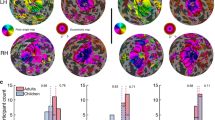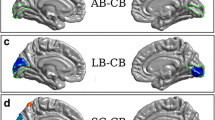Abstract
The visual system undergoes major modifications during the first year of life. We wanted to examine whether the magnocellular (M) and parvocellular (P) pathways mature at the same rate or if they follow a different developmental course. A previous study carried out in our laboratory had shown that the N1 and P1 components of pattern visual evoked potentials (PVEPs) were preferentially related to the activity of P and M pathways, respectively. In the present study, PVEPs were recorded at Oz in 33 infants aged between 0 and 52 weeks, in response to two spatial frequencies (0.5 and 2.5 c deg−1) presented at four contrast levels (4, 12, 28 and 95%). Results indicate that the P1 component appeared before the N1 component in the periods tested and was unambiguously present at birth. The P1 component showed a rapid gain in amplitude in the following months, to reach a ceiling around 4–6 months. Conversely, the N1 component always appeared later and then gained in amplitude until the end of the first year without reaching a plateau. Latencies were also computed but no developmental dissociation was revealed. Results obtained on amplitude are interpreted as demonstrating a developmental dissociation between the underlying M and P pathways, suggesting that the former is functional earlier and matures faster than the latter during the first year of life
Similar content being viewed by others
References
Livingstone M, Hubel D. Segregation of form, color, movement, and depth: Anatomy, physiology, and perception. Science 1988; 240: 740-9.
Rakic P. Genesis of the dorsal lateral geniculate nucleus in the rhesus monkey: site and time of origin, kinetics of proliferation, routes of migration and pattern of distribution of neurons. JComp Neurol 1977; 176: 23–52.
Rakic P. Prenatal development of the visual system in the rhesus monkey. Phil Trans Roy Soc London B 1977; 278: 245–60.
Williams RW, Rakic P. Elimination of neurons from the rhesus monkey's lateral geniculate nucleus during development. J Comp Neurol 1988; 272: 424–36.
Holstein GR, Pasik T, Pasik P, Hamori J. Early postnatal development of the monkey visual system II. Elimination of retinogeniculate synapses. Dev Brain Res 1985; 20: 15–31.
Mates SL, Lund JS. Developmental changes in the relationship between type 2 synapses and spiny neurons in the monkey visual cortex. JComp Neurol 1983; 221: 98–105.
Kogan CS, Zangenehpour S, Chaudhuri A. Developmental profiles of SMI-32 immunoreactivity in monkey striate cortex. Dev Brain Res 2000; 119: 85–95.
LeVay S, Wiesel TN, Hubel DH. The development of ocular dominance columns in normal and visually deprived monkeys. JComp Neurol 1980; 191: 1–51.
Kennedy H, Bullier J, Dehay C. Cytochrome oxidase activity in the striate cortex and lateral geniculate nucleus of the newborn and adult macaque monkey. Exp Brain Res 1985; 61: 204–9.
Gottlieb M, Pasik P, Pasik T. Early post-natal development of the monkey visual system I. Growth of the lateral geniculate nucleus and striate cortex. Dev Brain Res 1985; 17: 53–62.
Abramov I, Gordon J, Hendrickson A, Hainline L, Dobson V, LaBossiere E. The retina of the newborn human infant. Science 1982; 217: 265–7.
Hendrickson A, Yuodelis C. The morphological development of the human fovea. Ophthalmology 1984; 91: 603–12.
Yuodelis C, Hendrickson A. A qualitative and quantitative analysis of the human fovea during development. Vision Res 1986; 26: 847–55.
Wadhwa S, Veena B. Cyto-differentiation and developing neuronal circuitry in the human LGN. Int JDev Neurosci 1988; 6: 59–75.
Movshon JA, Kiorpes L, Hawken MJ, Skoczenski AM, Cavanaugh JR, Graham NV. Sensitivity of LGN neurons in infant macaque monkey. Invest Ophthalmol Vis Sci (suppl.) 1997; 15: S498.
Ellemberg D, Hammarrenger B, Lepore F, Roy M-S, Guillemot J-P. Contrast dependency of VEPs as a function of spatial frequency: the parvocellular and magnocellular contributions to human VEPs. Spatial Vision 2001; 15: 99–111.
McCulloch DL, Orbach H, Skarf B. Maturation of the patternreversal VEP in human infants: a theoretical framework. Vision Res 1999; 39: 3673–80.
McCulloch DL, Skarf B. Development of the human visual system: monocular and binocular pattern VEP latency. Invest Ophthalmol Vis Sci 1991; 32: 2372–81.
Roy M-S, Barsoum-Homsy M, Orquin J, Benoit J. Maturation of binocular pattern evoked potentials in normal full-term and pre-term infants from 1 to 6 months of age. Pediatr Res 1995; 37: 140–4.
Dobkins KR, Anderson CM., Kelly J. Development of psychophysically-derived detection contours in L-and M-cone contrast space. Vision Res 2001; 41: 1791–807.
Dobkins KR, Anderson CM, Lia B. Infant temporal contrast sensitivity functions (tCSFs) mature earlier for luminance than for chromatic stimuli: evidence for precocious magnocellular development? Vision Res 1999; 39: 3223–39.
Dobkins KR, Lia B, Teller DY. Infant color vision: temporal contrast sensitivity functions for chromatic (Red/Green) stimuli in 3-months-olds. Vision Res 1997; 37: 2699–716.
Dobkins KR, Teller DY. Infant motion: Detection (M:D) ratios for chromatically defined and luminance-defined moving stimuli. Vision Res 1996; 36: 3293–310.
Crognale MA, Kelly JP, Weiss AH, Teller DY. Development of the spatio-chromatic visual evoked potential (VEP): a longitudinal study. Vision Res 1988; 38: 3283–92.
Madrid M, Crognale MA. Long-term maturation of visual pathways. Visual Neurosci 2000; 17: 831–7.
Norcia AM, Tyler CW, Hamer RD. Development of contrast sensitivity in the human infant. Vision Res 1990; 30: 1475–86.
Harris L, Atkinson J, Braddick O. Visual contrast sensitivity of a 6-month-old infant measured by the evoked potential. Nature 1976; 264: 570–1.
Allen D, Tyler CW, Norcia AM. Development of grating acuity and contrast sensitivity in the central and peripheral visual field of the human infant. Vision Res 1996; 36: 1945–53.
Sireteanu R, Fronius M., Constantinescu DH. The development of visual acuity in the peripheral visual field of human infants: binocular and monocular measurements. Vision Res 1994; 34: 1659–71.
Sireteanu R, Kellerer R, Boergen KP. The development of peripheral visual acuity in human infants, a preliminary study. Hum Neurobiol 1984; 3: 81–5.
Barnet AB, Friedman SL, Weiss JP, Ohlirich ES, Shanks B, Lodge A. VEP development in infancy and early childhood. A longitudinal study. Electroencephalogr Clin Neurophysiol 1980; 49: 476–89.
Huttenlocher PR. Morphometric study of human cerebral cortex development. Neuropsychologia 1990; 28: 517–27.
Michel AE, Garey LJ. The development of dendritic spines in the human visual cortex. Hum Neurobiol 1984; 3: 223–7.
Stein J. The magnocellular theory of developmental dyslexia. Dyslexia 2001; 7: 12–36.
Kraemer M., Abrahamsson M., Sjöström A. The neonatal development of the light flash visual evoked potential. Doc Ophthalmol 1999; 99: 21–39.
Crognale MA, Kelly JP, Chang S, Weiss AH, Teller DY. Development of pattern VEPs: longitudinal measurements in human infants. Optom Vis Sci 1997; 74: 808–15.
Moskowitz A, Sokol S. Developmental changes in the human visual system as reflected by the latency of the pattern reversal VEP. Electroencephalogr Clin Neurophysiol 1983; 56: 1–15.
Sokol S, Jones K. Implicit time of pattern evoked potentials in infants: an index of maturation of spatial vision. Vision Res 1979; 19: 747–55.
Fiorentini A, Trimarchi C. Development of temporal properties of pattern electroretinogram and visual evoked potentials in infants. Vision Res 1992; 32: 1609–21.
Author information
Authors and Affiliations
Rights and permissions
About this article
Cite this article
Hammarrenger, B., Leporé, F., Lippé, S. et al. Magnocellular and parvocellular developmental course in infants during the first year of life. Doc Ophthalmol 107, 225–233 (2003). https://doi.org/10.1023/B:DOOP.0000005331.66114.05
Issue Date:
DOI: https://doi.org/10.1023/B:DOOP.0000005331.66114.05




